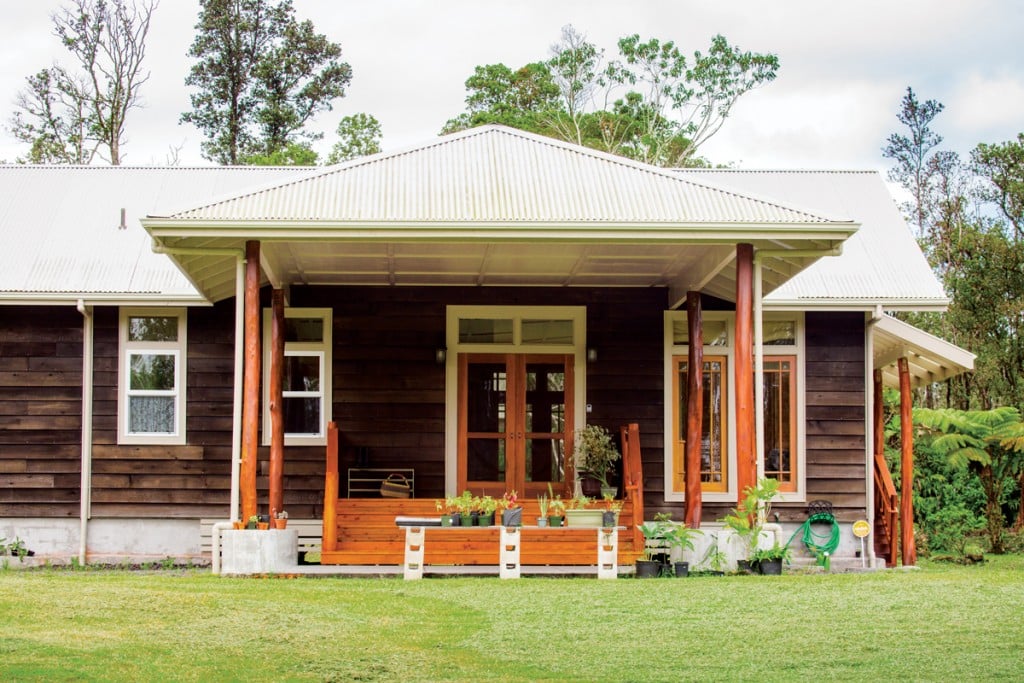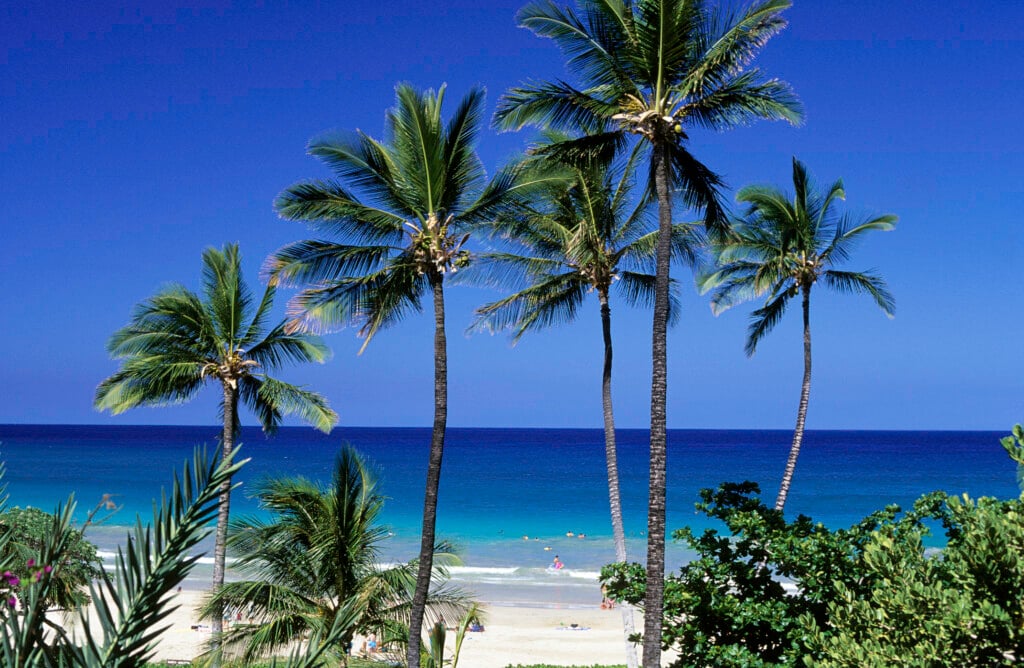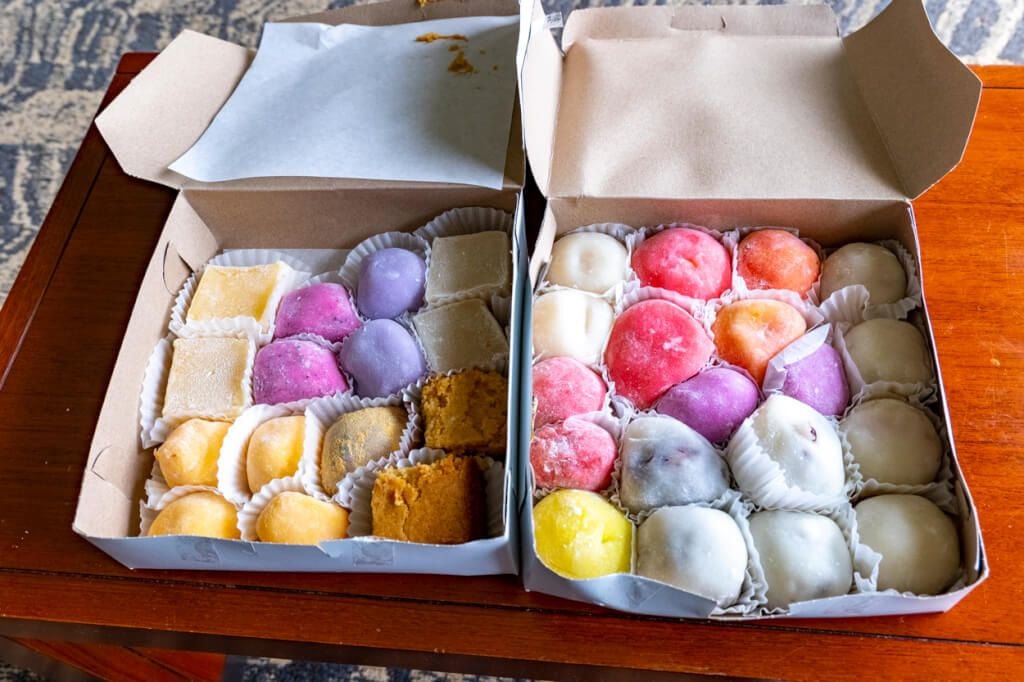How the Lyons Estate on Big Island is Preserving Hawaii’s Ohia Lehua Tree
The dedicated forest preserve is also an AirBnB.

I first spot them as I rumble along the long gravel road. The soft, bristled flowers are like mini red fireworks dotting the forest.
I’m in Mountain View, a small town about 15 miles east of Hilo, visiting a tucked-away property called the Lyons Estate. True to its name, Mountain View is known for its scenic vistas—Kilauea and Mauna Kea are next door—as well as its fertile soil once used to cultivate sugar and now home to tropical plant nurseries and coffee farms. But today I’m interested in just one tree: The ohia lehua.
Lacy Matsumoto and her husband, Dana Lyons, purchased the Lyons Estate, a 20-acre property, as their Hawaii Island getaway in 2017. The couple and their two young sons live on Oahu and have allowed visitors to rent their luxurious two-bedroom, 1 1/2 bath Hawaii Island home through Airbnb and Vacation Rental By Owner (VRBO). The native trees were one of the first things the couple noticed about the estate, says Matsumoto. On an island where many of these trees have fallen to a vicious fungal disease known as Rapid Ohia Death, the ohia lehua trees here thrive.

Photo: Jack Wolford
“I felt it was my responsibility to learn about these trees and how to take care of them,” says Matsumoto.
Ohia lehua are endemic to the Hawaiian Islands. You can find them growing at sea level and 5,000-foot elevations. They thrive in lush rain forests but are also the first trees to emerge from land layered with lava. The tree, with its bright red, pink, yellow or white feathery flowers can be short and shrubby or tall and fanning. The tree is also culturally significant. Its wood was used to make weapons, food through the creation of poi-pounding boards and medicine from its leaves. Ohia lehua appear frequently in Hawaiian mele (songs) and oli (chants), and it even has its own origin story.
According to Hawaiian legend, there once was a handsome warrior named Ohia. The fire goddess, Pele, liked Ohia, but he loved another woman named Lehua, and she him. Pele didn’t take the rejection well and turned Ohia into a tree. The other gods pitied the heartbroken Lehua, transforming her into a blossom on the tree to forever unite the two. The story says that whenever a lehua flower is picked, the two lovers cry, causing it to rain.

Photo courtesy: Lyons Estate
Over the past eight years, ohia lehua have experienced something far more detrimental than lovers’ separation. In 2010, landowners and farmers in the Puna district, an East Hawaii Island area that includes Mountain View, noticed something was killing the ohia lehua trees. The trees were wilting, browning and dying. Their deaths stumped federal, state and local researchers who began studying what was killing them and how. The disease was named Rapid Ohia Death, and it was killing swaths of ohia forests on the Big Island.
Researchers now know that two fungal pathogens, found only in Hawaii, kill ohia. As such, they were given Hawaiian names. The more aggressive ceratocystis, named lukuohia or “destroyer of ohia,” causes systemic wilt, while ceratocystis, named huliohia or “disruptor of ohia,” is a less aggressive and slower-moving fungus. The fungi enter the tree through a fresh opening in its bark, roots or branches, i.e., when the trees are pruned, damaged by strong winds or sharp lava rock, or grazed by an animal. The disease then spreads into the trunk, stopping water transport. To date, more than 150,000 acres of ohia trees have been affected by the fungi. In 2018, the disease was discovered in northeast Kauai.

Photo: Jack Wolford
While there’s still no cure for Rapid Ohia Death, the multiagency Rapid Ohia Death Working Group came up with a three-year strategic plan to combat the fast-killing fungus. It focuses on continued research of the disease, as well as prevention methods and community outreach. That’s where Matsumoto felt like she could make a difference.
The dense forest of ohia lehua trees at Lyons Estate, with their red puff blossoms, have managed to escape the life sucking fungi. Matsumoto isn’t sure why they’ve been spared, but she wants to use her healthy trees to educate others and aid in the restoration effort.
“I didn’t want to think about just our property, but other areas, too,” she says. “How do we stop this?”
The Lyons Estate is a dedicated forest preserve intent on protecting ohia lehua, says Matsumoto. This year, Matsumoto partnered with the University of Hawaii at Manoa Lyon Arboretum on Oahu to collect and bank seeds from healthy ohia trees to aid in eventual restoration efforts. (Dana Lyons is not related to Harold L. Lyon, the arboretum’s namesake.) Collecting the seeds is a simple, if not time-consuming process.
Matsumoto watches for the flowers to bloom and after they’re done, she removes intact seed pods from the tree, gathers the tiny seeds into a clean envelope—they’re smaller than Thyme leaves—and puts them in airtight storage at her Mountain View property. She did her first seed collecting this spring, gathering between 10,000 and 15,000 seeds. “I plan to do it again in the fall, but you have to take in account the weather,” she says. “The goal is to get 2 million seeds.”

Photo: Jack Wolford
Matsumoto’s work for the ohia lehua extends beyond the family’s 20 acres. She also does ohia tree plantings and seed collecting demos at schools, and often includes her sons as her helpers. “My kids love it!” she says. Her work even garnered the attention of Hawaii Gov. David Ige. This April, he declared every April 25 to be Ohia Lehua Day in Hawaii.
She says her Mountain View home is not only the starting point for her family’s preservation efforts, but serves as an entry to sustainable living in Hawaii for friends, family and outside visitors who stay at the home. The home is battery powered and has a diesel backup generator and a water catchment system. Visitors learn about ohia lehua, she says, and that off-the-grid living is “practical and possible.”
There’s no timeline for using the seeds, but they can last years in storage. In the meantime, Matsumoto’s growing seed bank will help researchers test for resistant ohia varieties and some day repopulate Hawaii’s native forests. Leaving Lyons Estate, I drive back down the gravel road, taking one last look at the ohia lehua. These resilient trees offer hope for their species. And with people like Matsumoto banking on their future, change is growing, one seed at a time.
Learn more about the Lyons Estate’s ohia lehua preservation efforts, and how to book a stay, at lyonsestate.com.


